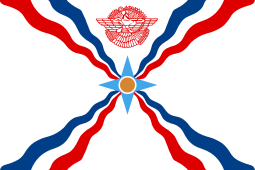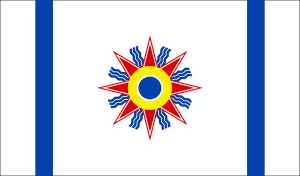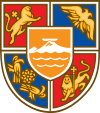Assyrians in Armenia
Assyrians in Armenia (Armenian: Ասորիներ, Āsōrīnēr) make up the country's third largest ethnic minority, after Yazidis and Russians. According to the 2011 census, there are 2,769 Assyrians living in Armenia,[1] and Armenia is home to some of the last surviving Assyrian communities in the Caucasus.[3] There were 6,000 Assyrians in Armenia before the dissolution of the Soviet Union, but because of Armenia's struggling economy during the 1990s, the population has been cut by half, as many have emigrated.[4]
| Total population | |
|---|---|
| 2,769 - 6,000[1][2] | |
| Regions with significant populations | |
| Languages | |
| Armenian, Russian, Aramaic | |
| Religion | |
| Mainly Christianity (majority: Syriac Christianity) |
History
Modern history
Today's Assyrian population in Armenia are mostly descendants of settlers who came starting in the early nineteenth century during the Russo-Persian War (1826-1828), when thousands of refugees fled their homeland in the areas around Urmia in Persia. In the beginning of the 20th century, many came from what is today Southeastern Turkey, specifically the Hakkari region, where it was common to have Assyrians and Armenians living in the same villages. Assyrians, like their Armenian neighbors, suffered during a genocide by the Ottoman Turks, in which an estimated over 750000 Assyrians perished.[5] As many Armenians fled Anatolia for what is today Armenia, many Assyrians followed as well, citing it as the only "Christian haven" in the region, although many also fled to Georgia (see Assyrians in Georgia). Throughout history, relations between the Assyrians and Armenian majority have tended to be very friendly, as both groups have practiced Christianity since ancient times and have suffered through persecution under Muslim rulers.the Assyrian and Armenian are the best friend for each other
The mixed Assyro-Armenian marriages are quite high on the percentage scale, this situation being also noted in Iraq and Iran, and in the Diaspora with adjacent Armenian and Assyrian communities. Historically, the Assyrians have always been described as men of gallantry, nearly always siding with the Armenians in rebellious situations. Along with other Christian populations they have been the subject of genocide within the Ottoman Empire and the Arab and Islamic world. The Armenian and the Assyrian nations have always been attached not only by confessional consensus, but rather by many centuries of collaboration and the correlative historical predestination.[6]
Nonetheless, the Assyrian Church of the East is considered heretical by the Armenian Apostolic Church, as the latter condemns the patron saint of the former, Nestorius. However, the Armenian Catholic Church and the Assyrian Chaldean Catholic Church are in full communion, and have brotherly relations.
Distribution

The Assyrian population in Armenia is mainly rural. Out of 3,409 Assyrians in Armenia 2,885 (84.6%) was rural and 524 (15.4%) urban.[8] According to the Council of Europe European Charter for Regional or Minority Languages there were four rural settlements with significant Assyrian population:
- Arzni in Kotayk Province - Assyrians and Armenians
- Verin Dvin, Ararat Province - Assyrians and Armenians
- Dimitrov, Ararat Province - Assyrians and Armenians
- Nor Artagers in Armavir Province - Assyrians, Armenians and Yezidis
Armenia
The Assyrians have managed to both integrate with Armenian society and maintain their own ethnic identity, as there are classes teaching the Aramaic language. Most Assyrians in the country are fluent in Armenian and Russian as well. Assyrians in Armenia today mostly belong to Assyrian Church of the East, but there is a small community belonging to the Chaldean Catholic Church as well. They mostly work in the fields of gardening, agriculture and viniculture. There are big Assyrian communities in the region of Verin Dvin and Dimitrov of the Ararat Marz, and Arzni of the Kotayk Marz. There is an Assyrian Youth Center in the Armenian capital, Yerevan. Mixed marriages between Assyrians and Armenians are becoming more common today, whereas Assyrians were strictly self-isolated in the two centuries before.
In 2003, the community established the "Assyrian Center BetNahrain", a club that promotes the studying and dissemination of the Assyrian language, culture, history and traditions, to the general public.[9]
Education
There are four public schools that are providing instructions in Assyrian:
- The Secondary School of Verin Dvin village (250 students in 2008)
- The Secondary School of Arzni village (114 students in 2008)
- The Secondary School of Dimitrov village (68 students in 2008)
- Alexander Pushkin no. 8 secondary School of Yerevan (8 students in 2008)
See also
- Armenian-Assyrian relations
- Assyrian people
- Assyrian diaspora
- Assyrian genocide
References
- 2011 Armenian Census
- Tour Armenia: Assyrians
- In his own autobiography, titled "OPEN", Andre Agassi consistently identifies his father as Armenian, and his mother (Betty Dudley) as an American from Illinois. Only twice does the word "Assyrian" appear(p.58; p.327). In both of those instances, according to Andre, his father is "cursing" or "trash-talking". At p. 29 of his autobiography, Andre claims his father speaks five languages, but Andre has consistently claimed Armenian heritage, and has consistently denied Assyrian heritage. In the autobiography of Andre's father -- "The Agassi Story" -- Andre's father consistently identifies himself of Armenian origin. There is not a single instance where one can find the word "Assyrian" anywhere in his book.
- Joseph Yacoub, La question assyro-chaldéenne, les Puissances européennes et la SDN (1908-1938), 4 vol., thèse Lyon, 1985, p.156
- The Ethnic Minorities of Armenia, Garnik Asatryan, Victoria Arakelova.
- The Burning Tigris: The Armenian Genocide and America's Awakening to International Human Rights By Peter Balakian.
- COE - Ethnic minorities in Armenia
- "BetNahrain - Assyrian Center in Armenia". Archived from the original on 2019-09-24. Retrieved 2019-09-24.



